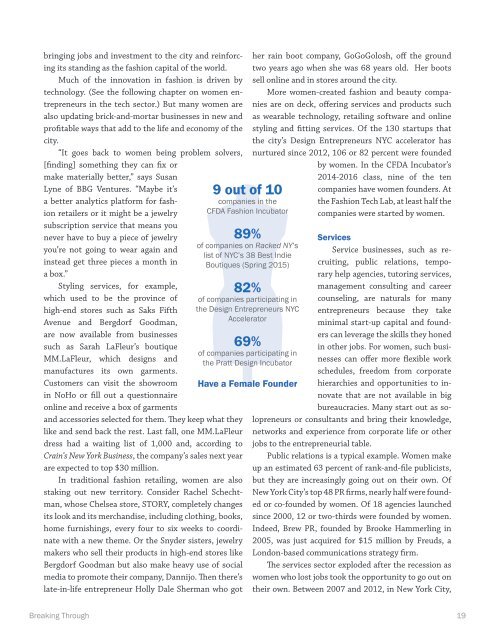BREAKING THROUGH
YWkgl
YWkgl
Create successful ePaper yourself
Turn your PDF publications into a flip-book with our unique Google optimized e-Paper software.
inging jobs and investment to the city and reinforcing<br />
its standing as the fashion capital of the world.<br />
Much of the innovation in fashion is driven by<br />
technology. (See the following chapter on women entrepreneurs<br />
in the tech sector.) But many women are<br />
also updating brick-and-mortar businesses in new and<br />
profitable ways that add to the life and economy of the<br />
city.<br />
“It goes back to women being problem solvers,<br />
[finding] something they can fix or<br />
make materially better,” says Susan<br />
Lyne of BBG Ventures. “Maybe it’s<br />
a better analytics platform for fashion<br />
retailers or it might be a jewelry<br />
subscription service that means you<br />
never have to buy a piece of jewelry<br />
you’re not going to wear again and<br />
instead get three pieces a month in<br />
a box.”<br />
Styling services, for example,<br />
which used to be the province of<br />
high-end stores such as Saks Fifth<br />
Avenue and Bergdorf Goodman,<br />
are now available from businesses<br />
such as Sarah LaFleur’s boutique<br />
MM.LaFleur, which designs and<br />
manufactures its own garments.<br />
Customers can visit the showroom<br />
in NoHo or fill out a questionnaire<br />
online and receive a box of garments<br />
and accessories selected for them. They keep what they<br />
like and send back the rest. Last fall, one MM.LaFleur<br />
dress had a waiting list of 1,000 and, according to<br />
Crain’s New York Business, the company’s sales next year<br />
are expected to top $30 million.<br />
In traditional fashion retailing, women are also<br />
staking out new territory. Consider Rachel Schechtman,<br />
whose Chelsea store, STORY, completely changes<br />
its look and its merchandise, including clothing, books,<br />
home furnishings, every four to six weeks to coordinate<br />
with a new theme. Or the Snyder sisters, jewelry<br />
makers who sell their products in high-end stores like<br />
Bergdorf Goodman but also make heavy use of social<br />
media to promote their company, Dannijo. Then there’s<br />
late-in-life entrepreneur Holly Dale Sherman who got<br />
9 out of 10<br />
companies in the<br />
CFDA Fashion Incubator<br />
89%<br />
of companies on Racked NY’s<br />
list of NYC’s 38 Best Indie<br />
Boutiques (Spring 2015)<br />
82%<br />
of companies participating in<br />
the Design Entrepreneurs NYC<br />
Accelerator<br />
69%<br />
of companies participating in<br />
the Pratt Design Incubator<br />
Have a Female Founder<br />
her rain boot company, GoGoGolosh, off the ground<br />
two years ago when she was 68 years old. Her boots<br />
sell online and in stores around the city.<br />
More women-created fashion and beauty companies<br />
are on deck, offering services and products such<br />
as wearable technology, retailing software and online<br />
styling and fitting services. Of the 130 startups that<br />
the city’s Design Entrepreneurs NYC accelerator has<br />
nurtured since 2012, 106 or 82 percent were founded<br />
by women. In the CFDA Incubator’s<br />
2014-2016 class, nine of the ten<br />
companies have women founders. At<br />
the Fashion Tech Lab, at least half the<br />
companies were started by women.<br />
Services<br />
Service businesses, such as recruiting,<br />
public relations, temporary<br />
help agencies, tutoring services,<br />
management consulting and career<br />
counseling, are naturals for many<br />
entrepreneurs because they take<br />
minimal start-up capital and founders<br />
can leverage the skills they honed<br />
in other jobs. For women, such businesses<br />
can offer more flexible work<br />
schedules, freedom from corporate<br />
hierarchies and opportunities to innovate<br />
that are not available in big<br />
bureaucracies. Many start out as solopreneurs<br />
or consultants and bring their knowledge,<br />
networks and experience from corporate life or other<br />
jobs to the entrepreneurial table.<br />
Public relations is a typical example. Women make<br />
up an estimated 63 percent of rank-and-file publicists,<br />
but they are increasingly going out on their own. Of<br />
New York City’s top 48 PR firms, nearly half were founded<br />
or co-founded by women. Of 18 agencies launched<br />
since 2000, 12 or two-thirds were founded by women.<br />
Indeed, Brew PR, founded by Brooke Hammerling in<br />
2005, was just acquired for $15 million by Freuds, a<br />
London-based communications strategy firm.<br />
The services sector exploded after the recession as<br />
women who lost jobs took the opportunity to go out on<br />
their own. Between 2007 and 2012, in New York City,<br />
Breaking Through 19


